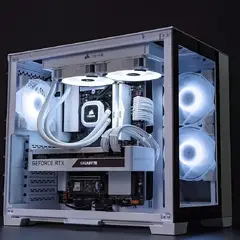-
Posts
40,200 -
Joined
-
Last visited
Awards
This user doesn't have any awards
Profile Information
-
Gender
Not Telling
-
Member title
Member
System
-
CPU
dual Xeon e5 2680 v2
-
Motherboard
Intel s2600cp
-
RAM
32GB DDR3R
-
GPU
rx480
-
Case
Phantex enthoo pro
-
Storage
4x 100GB SSDs + 6x 2TB HDDs
-
PSU
850 EVGA g2
-
Cooling
Deepcool IceBlade 200M
-
Operating System
Fedora 29
Recent Profile Visitors
17,519 profile views
Electronics Wizardy's Achievements
-

1 vs. 2 Computers? Beginner Homelab Questions
Electronics Wizardy replied to pikchu87's topic in Servers, NAS, and Home Lab
1 computer is probably better, but depends on your exact goals. Lot of options, probably used office pc or other low power system is the way to go unless you want a rack server for some reason. How much usable storage do you need? Basic plex and jellyfin will run on almost any semi moden system so really depends on yoru exact needs. -

Help with Windows 11 Storage Spaces please!
Electronics Wizardy replied to GokuGogo's topic in Troubleshooting
If you want to switch from mirrors to parity your best way to do it would be to add a parity virtual disk, then copy the data over, and shrink the mirror one and expand the parity one while doing this. I'd probably be easier if you just started fresh and restore backups though. With mirrors in storage spaces you can add a 3rd drive and get 50% of the total space as its not a traditional raid 1.- 7 replies
-
- raid
- windows 11
-
(and 1 more)
Tagged with:
-
There should also be public adblocking DNS servers you can use. I'd try using those first and see if they meet your needs.
-
Is there a big market for these laptops? Nvidia seems to have make them the 'better' brand for consumers, which likely helps drive sales over other brands. Better power efficiency helps too. I can see this making some sense with the right price, but with 4060 laptops being fairly cheap, I think it leaves a pretty small spot in the market for these.
-
Not significantly. Look here, all the reasonbly high end drives are extremly close in performance. https://www.techpowerup.com/review/crucial-t700-pro-4-tb/16.html Its gonna be way faster than a HDD, but the pcie gen doesn't matter for almost all workloads.
-
For media use over a 1gbe link, your not gonna really help performance much here by adding a SSD. The best is probably a cache drive, but it won't help much with this use case. Metadata probably won't help with big files, and if it fails you lose all your data. Log won't help over SMB and general fileserver use at all.
-

Synology NAS storage issue
Electronics Wizardy replied to thstudios's topic in Servers, NAS, and Home Lab
Make a shared folder on the synology. Here is their guide. https://kb.synology.com/en-global/DSM/help/DSM/AdminCenter/file_share_create?version=7 Then go under this pc, then map a network drive and it will show up as a drive letter on windows. -

Synology NAS storage issue
Electronics Wizardy replied to thstudios's topic in Servers, NAS, and Home Lab
You can mount the NAS drive in your OS, then it should show up likeanouther drive, and won't use any external disk space. -

Why Do They Do This With Phone Cameras??
Electronics Wizardy replied to moneyshot's topic in Phones and Tablets
Got any example models you can show? I wouldn't be surprised if readout speed is the issue. Lots of sensors are high res, but can't read the full res of the sensor ~30 times a second needed for 4k video. So they switch to a lower res mode that can do ~30fps readout, but at a lower resolution. Could easily be an artificial limit too. Also arguably 4k doesn't matter for these low end sensors and phones if the lens and sensor isn't good enough to really have a significant difference, why make the bigger files.




















